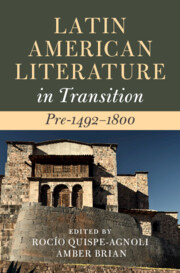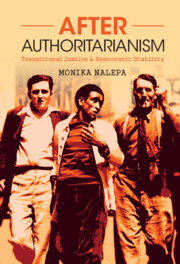46 results
Chapter 1 - Introduction
-
- Book:
- Transition Expertise and Identity
- Published online:
- 30 May 2024
- Print publication:
- 06 June 2024, pp 1-8
-
- Chapter
- Export citation
Mapping 15-year depressive symptom transitions in late life: population-based cohort study
-
- Journal:
- The British Journal of Psychiatry , FirstView
- Published online by Cambridge University Press:
- 30 May 2024, pp. 1-7
-
- Article
-
- You have access
- Open access
- HTML
- Export citation
8 - Goals of Care in Late-Stage Disease
-
- Book:
- Navigating Communication with Seriously Ill Patients
- Published online:
- 05 April 2024
- Print publication:
- 25 April 2024, pp 116-135
-
- Chapter
- Export citation
Chapter 1 - Taking Children and Young People Seriously
-
- Book:
- Taking Children and Young People Seriously
- Published online:
- 08 June 2023
- Print publication:
- 22 June 2023, pp 1-18
-
- Chapter
- Export citation
5 - Unrecognized Mechanisms, Normality and Everyday Realities in Transition
-
- Book:
- Navigating Local Transitional Justice
- Published online:
- 13 July 2023
- Print publication:
- 11 May 2023, pp 134-157
-
- Chapter
- Export citation
1 - Introduction
-
- Book:
- Five Times Faster
- Published online:
- 19 March 2023
- Print publication:
- 06 April 2023, pp 1-6
-
- Chapter
-
- You have access
- HTML
- Export citation
20 - System Change, Not Climate Change
- from Part III - Diplomacy
-
- Book:
- Five Times Faster
- Published online:
- 19 March 2023
- Print publication:
- 06 April 2023, pp 214-230
-
- Chapter
- Export citation

Five Times Faster
- Rethinking the Science, Economics, and Diplomacy of Climate Change
-
- Published online:
- 19 March 2023
- Print publication:
- 06 April 2023
Chapter 1 - Revolutions and Literary Transitions: The 1960s
- from Part I - War, Revolution, Dictatorship
-
-
- Book:
- Latin American Literature in Transition 1930–1980
- Published online:
- 24 January 2023
- Print publication:
- 08 December 2022, pp 17-31
-
- Chapter
- Export citation
Chapter 1 - Revolutions and Literary Transitions
- from Part I - War, Revolution, Dictatorship
-
-
- Book:
- Latin American Literature in Transition 1930–1980
- Published online:
- 24 January 2023
- Print publication:
- 08 December 2022, pp 17-31
-
- Chapter
- Export citation

Latin American Literature in Transition Pre-1492–1800
-
- Published online:
- 25 November 2022
- Print publication:
- 08 December 2022

After Authoritarianism
- Transitional Justice and Democratic Stability
-
- Published online:
- 15 September 2022
- Print publication:
- 22 September 2022
Assessing the feasibility of MOVING FORWARD, a multicentre transition intervention model across adolescent secure services in England: A cluster randomised feasibility trial
-
- Journal:
- European Psychiatry / Volume 65 / Issue S1 / June 2022
- Published online by Cambridge University Press:
- 01 September 2022, pp. S232-S233
-
- Article
-
- You have access
- Open access
- Export citation
Reframing Chinese Business History
-
- Journal:
- Business History Review / Volume 96 / Issue 2 / Summer 2022
- Published online by Cambridge University Press:
- 14 December 2021, pp. 245-287
- Print publication:
- Summer 2022
-
- Article
- Export citation
A feasibility study on a novel well-being intervention for university students
-
- Journal:
- Irish Journal of Psychological Medicine , First View
- Published online by Cambridge University Press:
- 24 November 2021, pp. 1-5
-
- Article
- Export citation
A Scoping Review of Care Trajectories across Multiple Settings for Persons with Dementia
-
- Journal:
- Canadian Journal on Aging / La Revue canadienne du vieillissement / Volume 41 / Issue 1 / March 2022
- Published online by Cambridge University Press:
- 12 July 2021, pp. 71-95
-
- Article
-
- You have access
- Open access
- HTML
- Export citation
Introduction
-
-
- Book:
- African American Literature in Transition, 1800–1830
- Published online:
- 11 March 2021
- Print publication:
- 13 May 2021, pp 1-14
-
- Chapter
- Export citation
Modelling national transformations to achieve the SDGs within planetary boundaries in small island developing states
- Part of
-
- Journal:
- Global Sustainability / Volume 4 / 2021
- Published online by Cambridge University Press:
- 21 April 2021, e15
-
- Article
-
- You have access
- Open access
- HTML
- Export citation
Transitions in loneliness in later life: the role of social comparisons and coping strategies
-
- Journal:
- Ageing & Society / Volume 42 / Issue 7 / July 2022
- Published online by Cambridge University Press:
- 30 November 2020, pp. 1607-1628
- Print publication:
- July 2022
-
- Article
-
- You have access
- Open access
- HTML
- Export citation
6 - Post-uprising Eras and (Tentative) Regime Re-formations
-
- Book:
- Military Politics of the Contemporary Arab World
- Published online:
- 16 October 2020
- Print publication:
- 29 October 2020, pp 216-278
-
- Chapter
- Export citation



